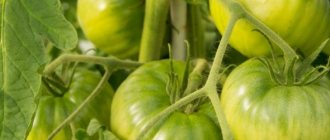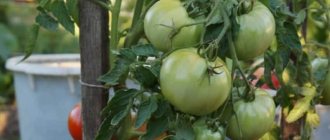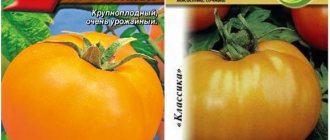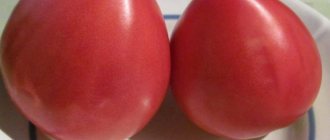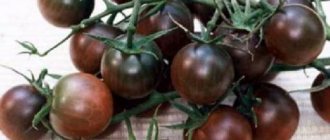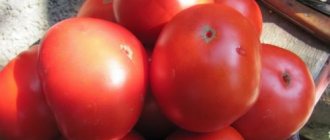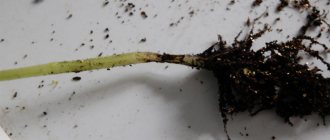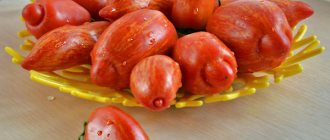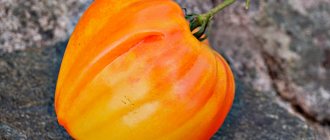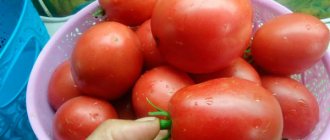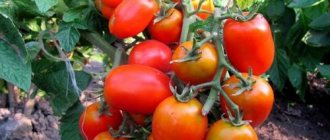The King of Siberia reigns in the gardens of Siberians and other residents of cold regions, although he is not even in the State Register. But its advantages are confirmed by the experience of many vegetable lovers. Bright yellow fruits are what you need after a cold winter.
| Height | Landing location | Ripening time | Fruit color | Fruit size | Origin | Fruit shape |
| Tall | Greenhouse, Open ground | Mid-season | Yellow | Large | Variety | Heart-shaped |
Characteristics and description of the variety
The King of Siberia tomato was developed relatively recently. It is not included in the State Register, as it is at the stage of experimental research. The copyright holder of the variety is agro. Now it is one of the leaders in the field of selection and development of new crops.
Distinctive features
The type is indeterminate, that is, unlimited in growth, with a height of 2 meters or more. The stem is strong, there are 5 clusters on the stem, each bearing 3-5 fruits. The foliage is weak, the leaves are small, dark green. The root system is powerful.
The ripening period is average, from the moment of sowing the seeds to full ripening, 110-120 days pass.
The productivity is high, 3-3.5 kg of fruits are harvested from 1 seedling, provided that 3 plants are planted per 1 square meter. m.
Tomato genes contain resistance to fungal and bacterial diseases; the culture is immune to late blight , tobacco mosaic, and Alternaria. Recommended for cultivation in open ground and in greenhouse conditions.
Tomatoes require regular pinching due to the large number of shoots and obligatory staking of tall bushes. Otherwise, the fruit-bearing branches will not withstand the weight of ripe vegetables.
Fruit characteristics
The fruits are large, weight reaches 400-800 g. The shape is heart-shaped, the color is bright orange. The taste is sweet due to the high glucose content, the pulp is juicy, and there are few seeds.
The purpose of tomatoes is universal: they are consumed fresh and used for winter preparations. Smaller tomatoes can be preserved whole; they look especially beautiful together with red tomatoes.
Reference. Yellow vegetables are rich in beta-carotene and are not allergens, unlike red ones. Therefore, they are suitable for children's and diet food.
The crop is grown in summer cottages and farms and used for commercial purposes.
The photo shows the King of Siberia tomatoes.
Small-fruited tomatoes
Cherry and cocktail tomatoes are very similar, so they can be separated into a separate category - miniature tomatoes come in a variety of colors and have excellent taste characteristics. The weight of cherry tomatoes is 15-30 g. Cocktail tomatoes are slightly larger - their weight reaches 40-60 g. Small tomatoes have a universal purpose - they are eaten fresh or canned whole.
Granddaughter
The main stem grows to a maximum of 50 cm and does not need tying. The fruits are round, red, average weight - 20 g. Productivity - about 1.5 kg per plant. Under favorable weather conditions, it almost doubles.
Honey candy F1
This hybrid belongs to the mid-early category (110 days). The bush is low (80 cm), formed from 2-3 stems (they are fixed on a support). Up to 6 clusters are formed on each stem. Cherry shape is plum-shaped, color is yellow, weight is about 30 g. The taste is excellent. Productivity – up to 6 kg per 1 sq.m.
Chocolate bunny
The plant is powerful, reaches a height of 120 cm. Requires pinching. Productivity – up to 5 kg per 1 sq.m. The plum-shaped fruits have an excellent taste, weight – 30 g. When fully ripe, the color changes from red to chocolate. The harvest is well stored. Cherries make an excellent buffet appetizer; they can be canned or dried.
Black Cherry
The variety is very popular due to its sweet taste. The plant is powerful and enters the fruiting period after 120 days or a little earlier. It is disease resistant. Productivity is about 5 kg per 1 sq.m. A special feature is the increased need for fertilizing. The main part of the harvest is formed on the side shoots. Cherry color is almost black, weight is about 20 g.
Green Tiger
This variety allows you to get a cherry harvest with emerald pulp. The skin is colored light green, with darker stripes visible against the general background. The consistency of the pulp is dense, the taste is rich, very sweet. The weight of 1 tomato is about 30 g, up to 12 pieces are formed in each brush. The bush is unpretentious and tolerates changeable weather conditions. Average yield – 4-5 kg/sq.m. Stem height – up to 1.8 m (support required). Ripening takes 90-95 days.
Geranium Kiss (USA)
Cocktail variety. The bush is compact, low (50 cm). The fruits are oval in shape with a narrow “spout”. The pulp is dense and sweet. Green and brown tomatoes ripen without deteriorating in taste. They are removed from the bush in clusters. Transportability is good. The plant is disease resistant. Productivity is high - Geranium Kiss forms up to 5 clusters, each of which contains 60-100 fruits weighing about 40 g.
Cartridge
Patron is another variety of cocktail tomatoes. Productivity – up to 10 kg per 1 sq.m. The average weight of 1 tomato is 40-50 g. Color is red, shape is cylindrical. The pulp has excellent taste characteristics.
How to grow seedlings
Planting of seedlings begins at the end of March. The crop is not a hybrid, which means it is possible to select seeds for planting from the fruits. Seed material collected independently undergoes mandatory preparation before sowing.
Seed preparation
Seeds are determined for emptiness by immersing them in a saline solution for 10 minutes. Those seeds that float to the surface are not suitable for planting. The remaining grains are disinfected in a weak solution of potassium permanganate for 30 minutes. After this, they are washed with running water.
Reference. Manganese solution can be replaced with 2% hydrogen peroxide.
To increase the germination percentage, the seeds are soaked in a growth stimulator for 10-12 hours. Specialized preparations can be replaced with potato juice, aloe juice or regular boiled water.
Container and soil
The soil is prepared from compost, river sand and garden soil in equal proportions. All components are thoroughly mixed and poured with a hot solution of potassium permanganate to destroy pathogenic flora. The cooled soil is laid out in planting containers, at the bottom of which small drainage holes are made in advance, where excess moisture will drain.
You can plant in a common wooden box or individual containers: plastic and peat cups or paper honeycombs.
Reference. When sowing seeds in plastic cups, drainage holes in the bottom are required. Otherwise, when moisture stagnates, there is a high probability of blackleg occurring.
Sowing
Seed material is sown to a depth of 2 cm with a distance of 1.5-2 cm from each other. Sprinkle peat on top, compact and water with warm, settled water using a spray bottle. Then cover with film to create a greenhouse effect and leave in a bright and warm room at a temperature of at least 22°C. Periodically the film is removed for ventilation.
Seedling care
When seedlings appear, the containers are moved to the windowsill to receive the required amount of light. Daylight hours for seedlings should be at least 13 hours. If there is a lack of natural light, they are illuminated with fluorescent phytolamps.
Reference. With insufficient lighting, the seedlings stretch upward and weaken.
Water moderately, without flooding the sprouts, with warm, settled water using a shallow watering can. After watering, the soil is loosened superficially, thereby ensuring the saturation of the soil with oxygen.
When 4 true leaves are formed, the seedlings are planted in separate containers. Picking involves shortening the main spine by one third. After this procedure, the seedlings develop more intensively.
Attention. When using peat cups, picking is not required.
2 weeks before planting in the ground, seedlings begin to harden off by taking the planting containers outside in the daytime for 1 hour. The hardening procedure allows young plants to quickly get used to new conditions after transplanting into the ground. Every day the time spent on the street increases to 12 hours.
Features of cultivation and care
It is possible to obtain a high yield from this crop if all requirements regarding cultivation technology are met. Tomatoes need proper care and timely fertilizing.
Recommendations that you should familiarize yourself with before landing the King of Siberia are as follows:
- the soil should be light without a high clay content, loose and well fertilized;
- You can plant tomatoes in place of cabbage, carrots, legumes, cucumbers or onions;
- the first step in cultivation is sowing seed material (March), subsequent picking of seedlings, application of fertilizers, hardening of young plants;
- per 1 m² you can plant 3 – 4 bushes. This planting density is the same for both open areas and greenhouses;
- the formation of bushes assumes the presence of one or two stems. One stepson is left so that the second stem can develop; all the rest must be removed. It is best to do this before the stepsons grow more than 5 cm, otherwise you can injure the plant;
- It is recommended to immediately tie tall seedlings to supporting structures.
Watering
It is best to water the plants in the morning using warm water. When growing in greenhouses, it is worth setting aside a small corner in the room where a container for storing and warming liquid will be placed.
Tomatoes respond well to root watering and react very poorly to water getting on the foliage parts. As for the frequency of application of liquid, this is done once every 7 days. If we talk about the amount of water, then it all depends on the size of the tomatoes. For newly planted seedlings you will need 1 liter per bush. When the seedlings begin to grow, the dosage must be increased to an average of 5 - 10 liters per plant. This volume is maintained until the period of fruit formation.
14–21 days before the expected date of appearance of the first tomatoes, watering is reduced. This is necessary for faster formation of ovaries. Here, one liter of water is used per plant, once every 7 days. Then the amount of liquid needs to be increased again, but not to overdo it to avoid cracking the skins of the tomatoes.
As for growing the King of Siberia in an open area and watering it, the volumes and timing indicated above and recommended for greenhouse plants are maintained. The exception is when there is heavy rainfall, after which watering is not needed. You need to pick up a watering can at the moment when the soil is completely dry under the bushes.
Helpful advice. If the sun immediately appears after rain, it is recommended to remove water from the foliage so that the plants do not get burned. This can be done using a soft broom or simply gently shaking the bushes.
Fertilizer application
It will not be possible to get a good harvest without timely application of fertilizers and regular fertilizing, which is done along with watering once every 30 days . The time for applying complex fertilizers is in early spring. Fertilize the soil at the site of future planting of seedlings 4 - 14 days before the start of work. Mineral fertilizers for tomatoes should contain: phosphorus, potassium, nitrogen.
The best organic waste is considered to be natural waste from cows, horses or poultry. The easiest way to get it is mullein, bird droppings or horse manure; they are considered rarer, and they will also need to be diluted in water before use.
How to grow tomatoes
By June, the seedlings are ready to be transplanted into the ground. In greenhouse conditions, seedlings are planted 2 weeks earlier.
Landing
The soil is prepared 2 weeks before transplanting by digging and adding humus. They are transplanted into holes 15-20 cm deep, at the bottom of which a little sawdust or wood ash is first placed.
Planting pattern: 50 cm – distance between seedlings, 60 cm left between rows. For 1 sq. m place 3 plants in a checkerboard pattern. With this method, each bush receives a sufficient amount of light and is well ventilated.
After transplantation, the soil is compacted, watered with warm, settled water and the young bushes are left to get used to the new conditions for several days.
Further care
Regular watering is established no more than 2 times a week, water with warm, settled water at the root; tomato does not like watering leaves. Before fruiting begins, water abundantly, at least 5 liters of water per 1 seedling. When the ovaries form, watering is reduced, since excess moisture may cause the fruits to crack.
After watering, the soil is loosened, removing weeds with roots. Loosening saturates the root system with oxygen. To retain moisture in the beds, they are mulched with straw or peat. This is especially important on dry days.
The crop is fed three times per season: during flowering, at the time of ovary formation and during fruiting. A full complex of minerals or organic matter is used as fertilizers. Mineral fertilizers containing nitrogen are given 2-3 weeks after transplantation. Nitrogen helps plants grow green mass.
Fertilizers with a predominant content of phosphorus and potassium are given during the period of ovary formation and fruiting. Such fertilizing accelerates the ripening of fruits.
From organic matter, use mullein infusion or bird droppings in a ratio of 1:15. Such strong dilution is necessary so that the root system does not get burned.
Features of cultivation and possible difficulties
The indeterminate type requires mandatory staking of tall seedlings. The sooner you fix the stem to the support, the more powerful it will be formed. To do this, install a metal or wooden support next to each seedling and tie the stem to the support almost immediately after transplanting. In addition to the stem, fruit-bearing branches are fixed to the support as they grow.
The most convenient way of gartering is by fixing it to a trellis. Plants are fixed to a horizontally stretched wire with soft fabric tapes.
The culture needs regular pinching due to the large number of shoots. Stepchildren that have reached 5 cm are removed in the morning so that by the evening the wounds have time to heal. To prevent infection, the cut sites are sprinkled with ash or treated with a solution of potassium permanganate.
For maximum fruiting, the plant is grown in 1 or 2 stems.
Diseases and pests
Varietal characteristics include high resistance to diseases of the Solanaceae family. It is also immune to attacks from many pests. However, we should not forget about simple preventive measures, which include regular loosening, weeding, mulching and moderate watering. Agrotechnical rules recommend treating the beds with copper sulfate before planting tomatoes, which prevents fungal spores from developing.
In open ground, the Colorado potato beetle and its larvae are dangerous. Regular inspection of seedlings for the presence of the pest prevents the rapid proliferation of the parasite. Females lay larvae on the underside of the leaves, so careful inspection of the plants from all sides is necessary. If there are a lot of beetles, use the drug “Commander” or “Prestige”.
Reference. Treatment of plants with chemicals is carried out in sunny weather.
Diseases and pests: prevention and control methods
The plant of this variety is immune to Alternaria, Cladosporiosis, and late blight. Resistance to diseases allows you to obtain environmentally friendly tomatoes, since there is no need to regularly treat plants with chemicals.
Tomatoes of the “King of Siberia” variety may be attacked by pests:
- spider mite,
- greenhouse whitefly.
A soap solution helps to cope with spider mites, which is used to treat the affected parts of the plant until the pest is completely defeated. When tomatoes are damaged by greenhouse whitefly, the bush is treated with the drug “Confidor” at the rate of 1 ml per 10 liters of water.
The variety “King of Siberia” is susceptible to brown spot. They fight it with the help of the drugs “Barrier” and “Barrier” or use a folk remedy - garlic solution.
Prevention of the disease consists of observing the light regime and maintaining optimal humidity.
The nuances of breeding in open ground and in a greenhouse
When growing a bush with 2 stems, the highest quantitative indicator of fruiting is observed. In this way, the variety is grown mainly in cold regions. In the southern region, the culture is carried out in 1 stem.
With excess moisture, not only the root system suffers, but also cracking of the fruit is possible. In addition, the humidity level increases, which leads to the formation of mold. Excess moisture is most dangerous in closed structures, so greenhouses must be ventilated daily.
The lower leaves are removed from all plants, otherwise they will rot from constant contact with wet beds.
The growth of greenhouse plants is slightly higher than in open beds. To limit growth, pinch the top of the plant, preventing the development of new branches. During the period of fruit formation, it is important that the plant spends nutrients on the formation of ovaries, and not on the growth of unnecessary branches.
In open ground, it is recommended to plant tomatoes in a place shaded from the daytime sun. An excess of ultraviolet radiation inhibits plant growth, while a deficiency has no effect at all.
Bull's heart - large varieties of tomatoes
Many gardeners are familiar with this variety. Many people have long loved it for its extraordinary taste. Due to the lower water content, this tomato has a sugary pulp, very sweet and meaty. More often it is used fresh - in salads or juices. But for some types of canning this variety will be appropriate.
High-yielding species. The fruits ripen together, in large quantities. However, this variety is more prone to diseases than its competitors. It needs special care, feeding and plant treatment.
The bush is tall, up to 1 meter 80 centimeters. In greenhouse shelters, one bush can produce up to 13 kilograms of harvest. In open ground - 5-6 kilograms per bush.
Harvesting and application
The collection of “royal” tomatoes begins in August. The first fruits are especially large and are excellent for fresh consumption. They are used to make salads, a variety of snacks, hot and vegetable dishes. Ripe vegetables are processed into tomato products and used for preparing winter preparations: marinades and pickles. Yellow vegetables look especially beautiful in jars with red ones.
It is not necessary to wait for vegetables to fully ripen; they are able to gain color on their own at room temperature. This quality is especially valued in regions with short summers.
Due to their high glucose content, which imparts a sweet taste, vegetables are suitable for baby food. They are also recommended for allergy sufferers and for dietary purposes.
Advantages and disadvantages
Let's look at the positive aspects of the King of Siberia:
- high fruiting rate;
- the formation of ovaries does not depend on weather factors;
- mid-early ripening;
- ease of care;
- strong immunity to diseases;
- possibility of breeding in all regions;
- excellent taste;
- large yellow fruits;
- suitable for dietary nutrition;
- versatility in cooking;
- Possibility of use for commercial purposes.
Negative properties include:
- obligatory garter;
- regular stepsoning;
- cracking of fruits from excess moisture.
Features of cultivation
The tomato variety “King of Siberia” has a medium ripening period; therefore, in order to speed up fruiting, you need to sow as early as possible. If it is not possible to use phytolamps for additional illumination, then the optimal time for sowing is early March.
When growing, it should be taken into account that the variety is large-fruited and requires a lot of nutrients, which means more attention should be paid to the preparation of the soil mixture and fertilizing.
Growing seedlings
The yield of tomatoes depends on how well the seedlings are grown.
Warming up the seeds
In order for the seedlings to appear quickly and uniformly, the seed should be warmed up. To do this, we proceed as follows.
- Soak tomato seeds in a manganese solution (0.1 g per 100 g of water) for 15 minutes;
- Rinse under running water through a strainer;
- Place in a damp cloth;
- Wrap in a plastic bag;
- We send it to a place where the temperature will be within 24-26 ᵒC.
Soil mixture
To sow correctly and grow seedlings without additional fertilizing, buy the soil in a specialized store, or prepare it yourself according to the following recipe:
- fresh compost - 1/3 bucket;
- ripe humus - 1/3 of a bucket;
- garden soil - 1/3 bucket.
- sand - 1 kg;
- stove ash - 0.5 kg;
- superphosphate - 50 g;
- ammonium nitrate - 50 g.
Farmer reviews
Judging by the characteristics and reviews, the tomato is well known among gardeners, despite its short lifespan. However, many gardeners have already tried the variety on their plots. Here are their opinions about the tomato:
Natalya, Chelyabinsk: “I planted the seedlings in May, and collected the tomatoes in early August. I didn’t pay much attention to the tomatoes: I watered them, planted them and tied them up. On the first bunches real giants grew, weighing up to 600 g, the last ones are smaller. They went to pickle. They look very nice in a glass jar with reds.”
Elizaveta, Krasnoyarsk: “I saw the King of Siberia for the first time in photographs, the price suited me, and I decided to plant him at home. There is practically no care. During the growing season, the crop did not get sick, there were no pests. I collected 4 kg of vegetables from one plant. Tasty, sweet, no acid, with a pleasant aroma. I advise everyone to plant this variety on their site.”
Botanical characteristics of the tomato King of Siberia
The variety belongs to the indeterminate type, i.e. The growth of the bush has no restrictions. In this case, its height reaches from 50 to 180 cm. In terms of the time of fruit ripening, the variety is mid-season. The main feature is resistance at the genetic level to various tomato diseases. Many gardeners answer that the tomato never gets sick during the season.
Tomato bushes
There is little foliage on the bushes. But they are tall with a strong stem. The shape of the leaves is very similar to maple. The first inflorescence with ovary is formed only above the seventh leaf.
Fruit
Ripe tomatoes are heart-shaped. They are painted bright orange and are quite large. The weight of one fruit from the lower clusters can reach 400 grams, but usually these are only the first ripened tomatoes, the weight of subsequent ones is less - 220-300 grams each.
The peel of the pulp is dense and smooth, there is no ribbing. The structure of the pulp is dense, even a little dry. Gardeners really like the unusual sweet taste. Laboratory studies revealed that the fruits of this tomato contain many vitamins, especially beta-carotene, which is why doctors recommend it for children.
